Growing Fruit And Vegetables With A Little Help From The Bees
- Or: Feeding Yourself And FeedingThe Bees
Everyone surely knows by now that bees and other pollinators are essential for pollinating the most interesting and arguably most tasty proportion of our food crops – the usual figure quoted being that around a third of crops we eat depend on bees and other pollinators.
But, as someone who loves bees, and started squeezing food crops into my small garden, then being lucky enough to get an allotment (after an 8 year wait!), one of the pleasures of growing your own food is the knowledge that I can simultaneously feed the bees too!
Flowering Fruit And Vegetables Popular With Bees
Here are my favourite
crops and tips for feeding yourself and the bees!
Grow Kingly Kale!
Yes, that’s right, grow KALE for bees! Below you can see why: if you allow the plants to flower, the plant will be festooned with a tremendous abundance of very pretty yellow flowers.
In my view, the plant is sufficiently attractive when in flower to actually occupy a place toward the back of the flower border if wished.
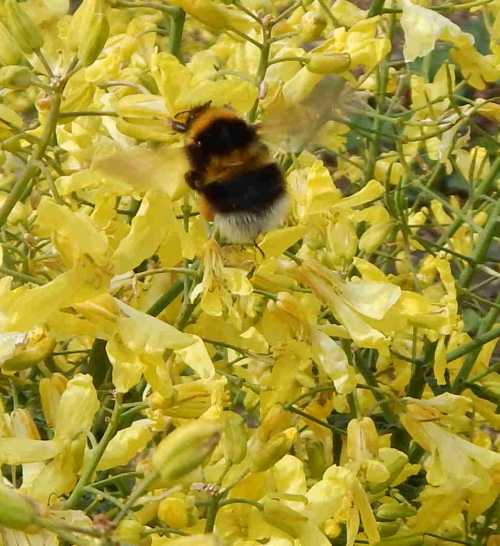 Bumble bee foraging on kale flowers.
Bumble bee foraging on kale flowers.
So what was my experience with this food crop?
In the spring of 2014, we decided to sow a
little Kale (actually, it was a free sample packet, so there were only a few
seeds in it) in a small section of an allotment bed. The variety was ‘Nero de Toscana’.
 A mass of fragrant yellow spring flowers, courtesy of the humble kale plant.
A mass of fragrant yellow spring flowers, courtesy of the humble kale plant.By the autumn, we were able to harvest
leaves abundantly, however, we also grow a number of other greens, including
Swiss chard, spinach beet and spinach, so we knew we had more than enough for
our needs.
We decided to leave the plants over winter, to continue harvesting in early spring. I noticed they had developed flower buds, and decided to leave them for longer - I have never grown kale before, but I had a gut feeling that bees would like the flowers. Many brassica flowers are a magnet for bees, and this was the case with kale.
By the time the end of April arrived, we had lots of delicately fragrant yellow flowers, and on a sunny day, the kale has been covered by all kinds of bees, including solitary and bumble bees, as well as other pollinators.
Kale is rich in vitamins, and very easy to grow. The stem is rather thick and sturdy, and it survived the winter to flower the following year.
Definitely among my favourite vegetables from a ‘feeds me and the bees’ perspective.
Grow Brilliant Beans!
 Beans from the allotment.
Beans from the allotment.I love beans: broad beans, runner beans, and French beans, and when we have space, we grow a mixture.
The bees love the flowers too. Unfortunately, we managed to get chocolate spot on the broad beans one year, but mostly we have success. The runner beans are excellent, helped in no small way by our fuzzy friends, the bees. I'm currently varying the varieties I grow in order to find out which ones I like most.
Different varieties have different flowers, and I have grown them with flowers that are:
- pale red and white,
- yellow and white,
- purple and white,
- red and white.
All have been visited by bees.
Onions - Obviously!
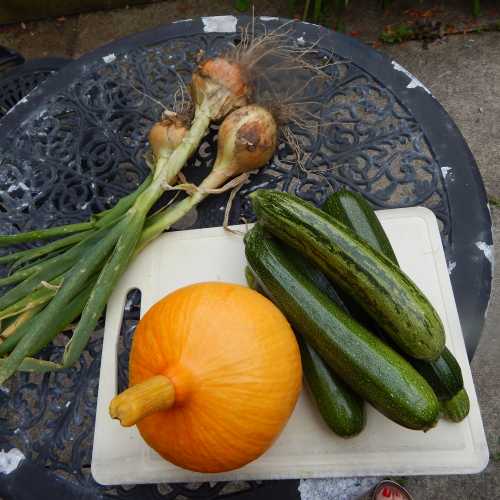 Onions, squash and courgettes from the allotment.
Onions, squash and courgettes from the allotment.
We always need onions in our house, but
being part of the allium family, it's no surprise that some bees like the flower heads. Onions are, however, self-pollinating, but that doesn't stop bumble bees enjoying them.
Ravishing Raspberries
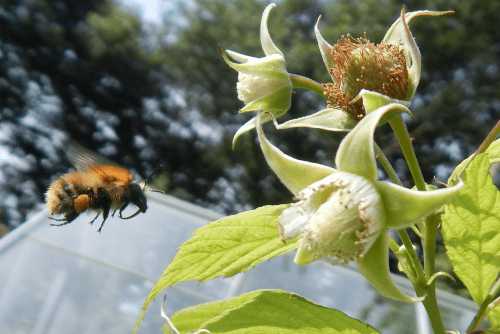 Bumble bees love raspberry flowers.
Bumble bees love raspberry flowers.
We have a mixture of both summer and autumn raspberries in the same patch by our greenhouse. I'm so glad we chose to do this, because it not only prolongs the raspberry picking season, the flowers provide food for pollinators for months, including the periods when flowers are less abundant for pollinators.
My raspberry patch typically attracts various bumble bee species, mason bees, honey bees, butterflies, hover flies and wasps - indeed the wasps help to pollinate the raspberries too.
I sometimes find that if the summer is a disappointing, the later autumn raspberry crop are less sweet (they start out okay, and become increasingly tasteless - I put this down to lack of sun).
In such circumstances, I would usually leave such berries to the birds, however, I find they are not so interested in them (whereas summer raspberries are frequently snaffled).
So why are the birds less interested? My personal view is that in autumn, birds will preferentially feed on invertebrates, seeds and 'fatty' berry types in order to store fat and energy for the winter. Thus a raspberry might not be quite so valuable for calories. People who live in warmer climates may have a different experience.
On the other hand, there comes a point when we feel we've had enough raspberries, and there are only so many pies I want to make. So, a few years ago, I decided to pick the raspberries for freezing, and at some point during the winter, I share the freezer crop with the birds: I mix the thawed out raspberries (juice and all) in bowl with suitable fat, flour and any other fruit I can spare, and bake the mixture in the oven. The birds really appreciate on cold, snowy days!
We get excellent raspberry crops every year, but find the autumn varieties are especially abundant with fruits.
Blueberry Bounty
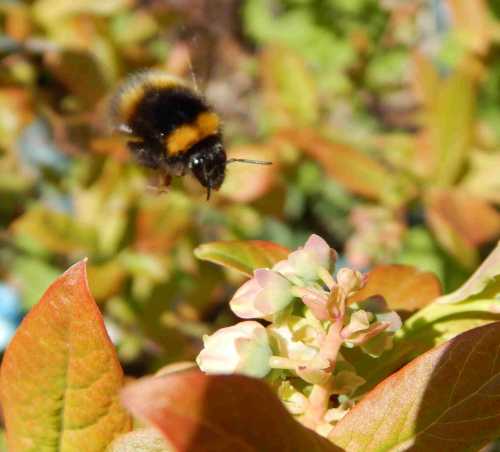 Bumble bee flying toward blueberry flower.
Bumble bee flying toward blueberry flower.I love blueberries and so do the
bees!
We have a small blueberry bush in our little garden. Various species of solitary bees and bumble bees can be seen pollinating the flowers.
Blueberry bushes need a certain amount of pruning to help them keep in good condition and ensure flowers, which will of course turn into fruits.
Scrumptious Strawberries
I remember reading a gardening book that raised a valid question: why were so many gardeners growing things they were not so keen on (like radishes) instead of focusing n things they really love, like strawberries?
'Good point!', I thought. I recall my dad sowing radishes, yet really, very few people in our large family actually enjoyed them. But somehow, it was the 'done thing' to grow them. (Now if you like radishes - fine!).
We have a small strawberry
patch at home, and are establishing one on our allotment. Bees pollinate the pretty white flowers.
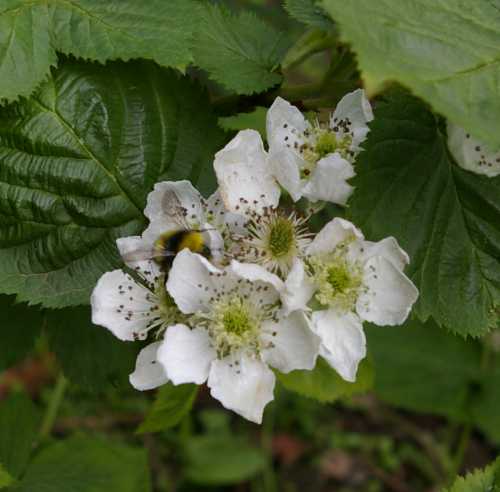 Bumble bee tucked away among the strawberry flowers.
Bumble bee tucked away among the strawberry flowers.After say 3 years, the plants are less productive, so you need to keep establishing new plants from the runners.
Courgettes and squashes
I'm always pleased when I see a large, open courgette flower with a bee inside it - in my garden, it's always bumble bees that do the pollinating.
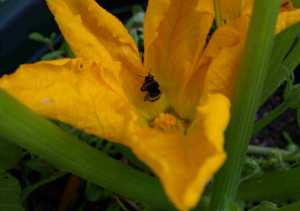 Bumble bee crawling out of a courgette flower.
Bumble bee crawling out of a courgette flower.Now, unfortunately, if you are not
seeing many bees in your area, you may have to pollinate courgettes
yourself.
This is achieved by removing the male flower, and pressing it into the centre of the female flower.
The male flower has no ‘fruitlet’ at the base of the flower, and the petals need to be picked off to expose the pollen-bearing anthers.
One male flower can be used to pollinate several females, but isn’t it so much better if the bees are doing the work for you?
Depending on space, I sometimes to grow these in pots, but since I got the allotment, I establish them at home in the greenhouse as small plants, then take them to the allotment and plant them out.
I know some people get fed up of courgettes if they grow quite a few plants and have a heavy crop, especially if they are not keen on making chutneys.
However, it is always worth remembering you can wash, chop and freeze courgettes as they are, then cook them from frozen – they are great added to pasta dishes.
Apples, Plums And Pears For Pies!
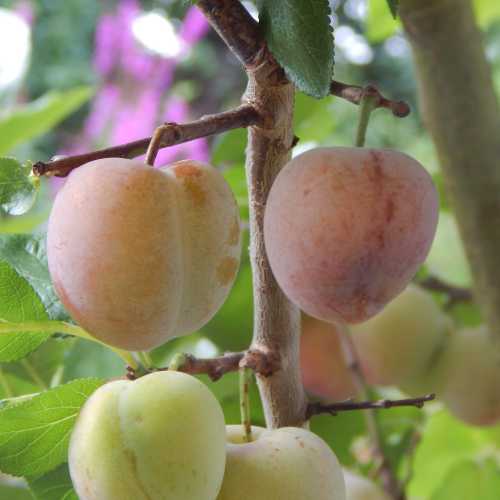 The spring flowers on our plum tree are visited by bees, and our plums are juicy and sweet.
The spring flowers on our plum tree are visited by bees, and our plums are juicy and sweet.Thank goodness for bees! Without them, I doubt would have so many lovely, ripe juicy plums, and I wouldn’t have as much fruit to make my own homemade fruit pies….or apple, orange, cinnamon, and hazelnut sponge cake, or my apple cake, or mixed fruit crumble……
Cheerful Cherries
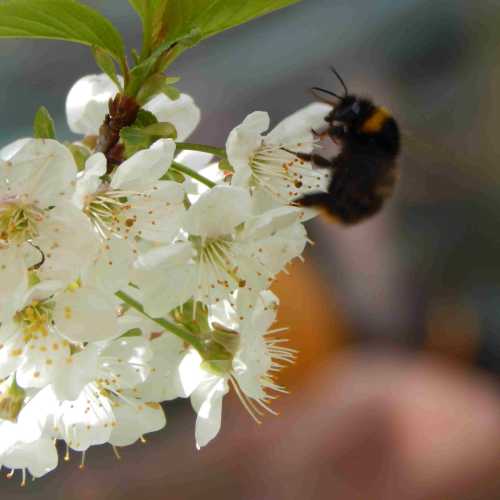 Bumble bee on cherry flower.
Bumble bee on cherry flower.A couple of years ago, we bought a miniature cherry tree.
The first year, the tree produced about 3 single
cherries, all of which were eaten by wildlife.
The second year, we had freak snow, which prevented the tree from being
pollinated.
In desperation, I went outside with a paint brush to try and pollinate the tree myself (hand pollination is actually a fact of life for some commercial growers where bees are now scarce), but alas I was too late. This year, I have seen quite a few bees on the tree, so fingers crossed!
More articles
- Clay Soil Plants for Bees Including trees and shrubs. Plants that will thrive in clay soil, and attract bees and other pollinators.
- Drought Plants for Bees and Pollinators Drought plants guide - panting for Bees and Pollinators: herbs, succulents, and wildflowers for dry conditions, and that attract bees and other pollinators
- Plants to Attract Bees: Shrubs, Hedgerows, and Trees For bees and other pollinators by season. Links to more lists of plants, wildflowers, herbs for bees.